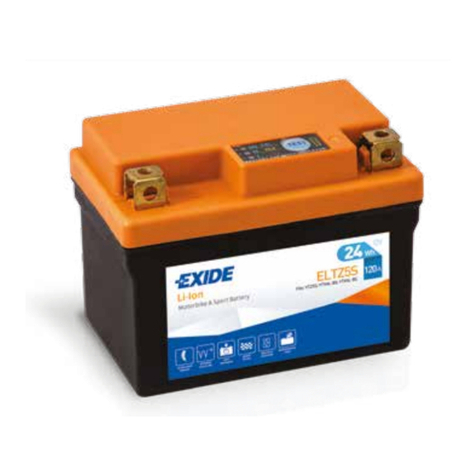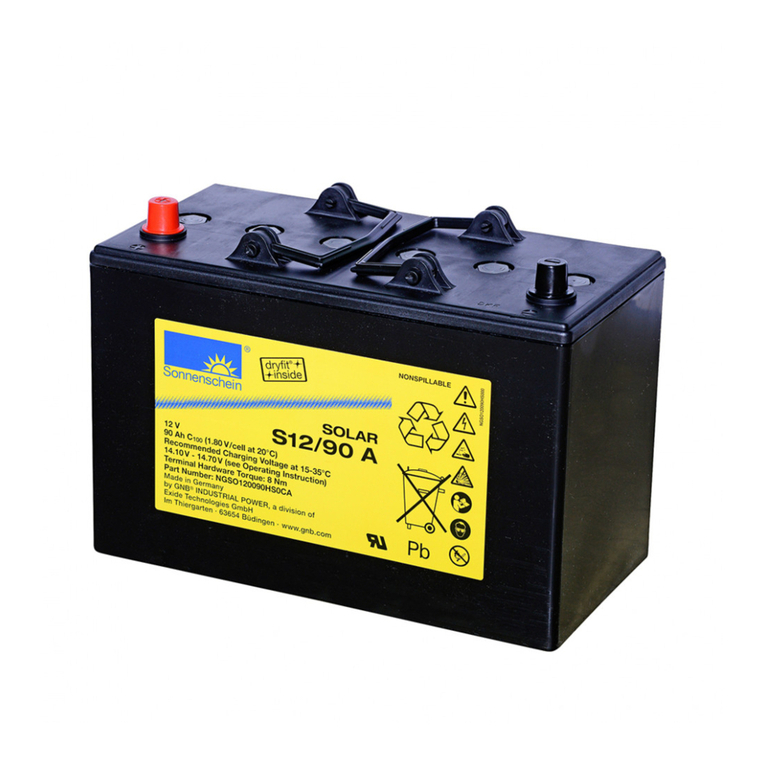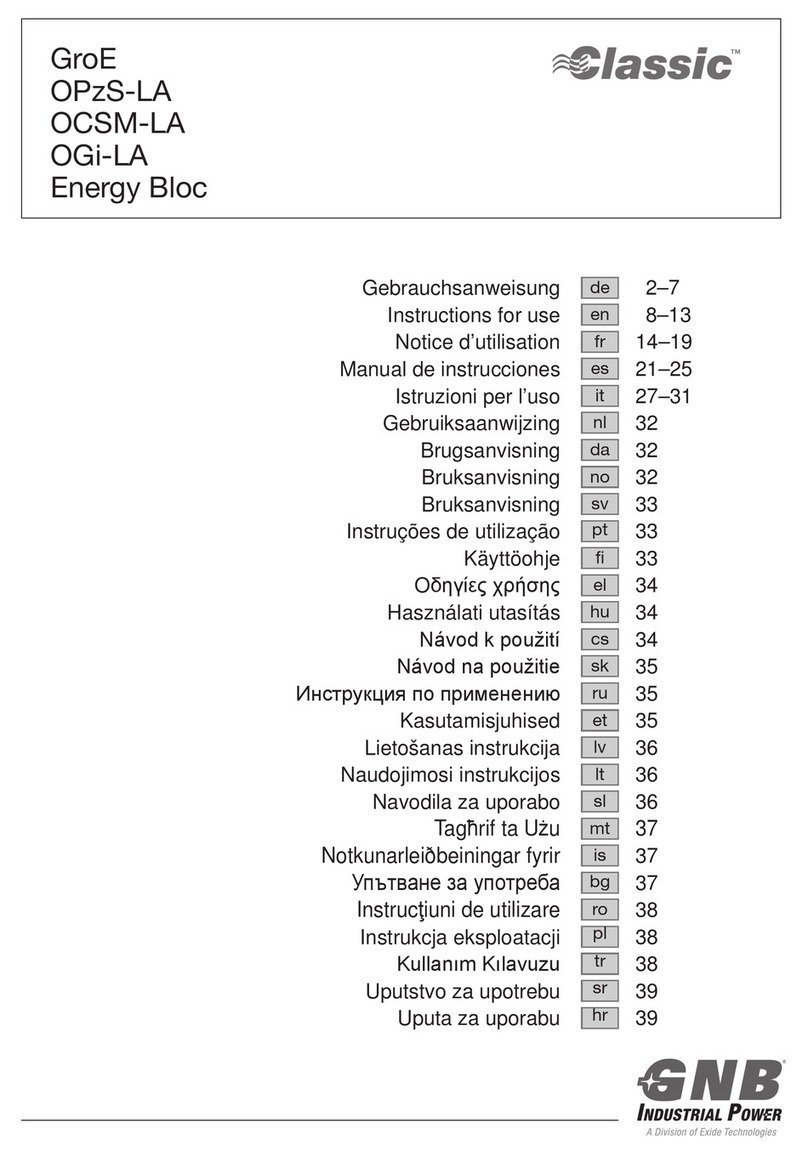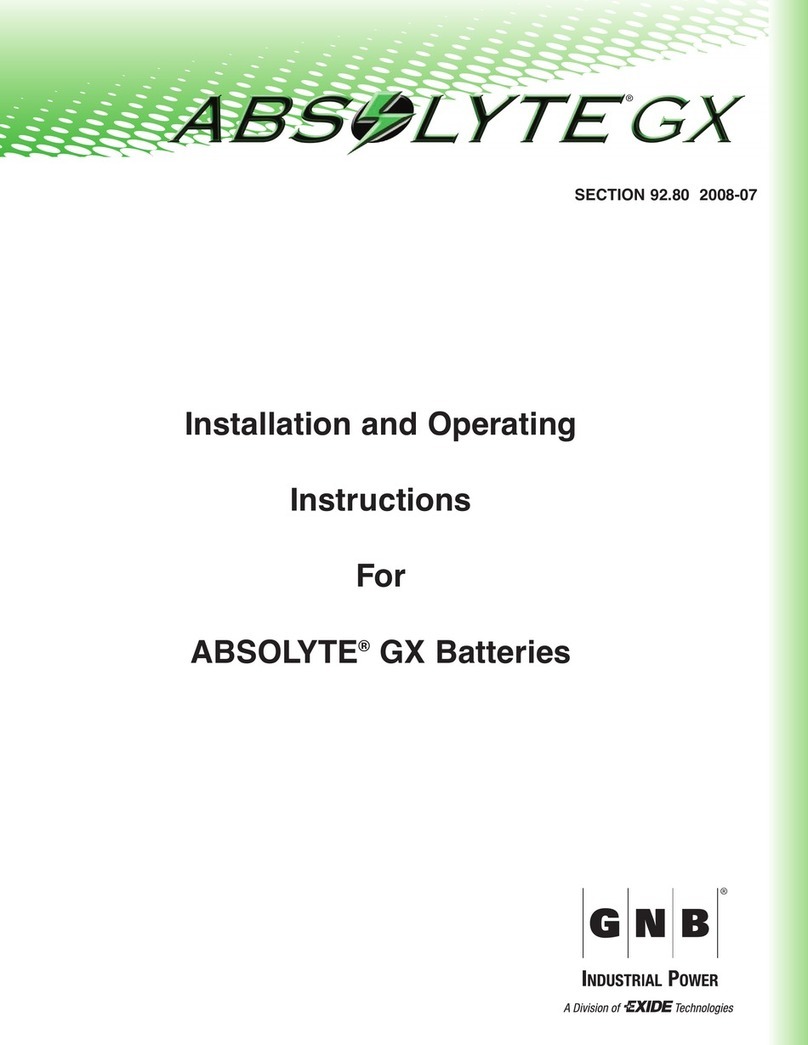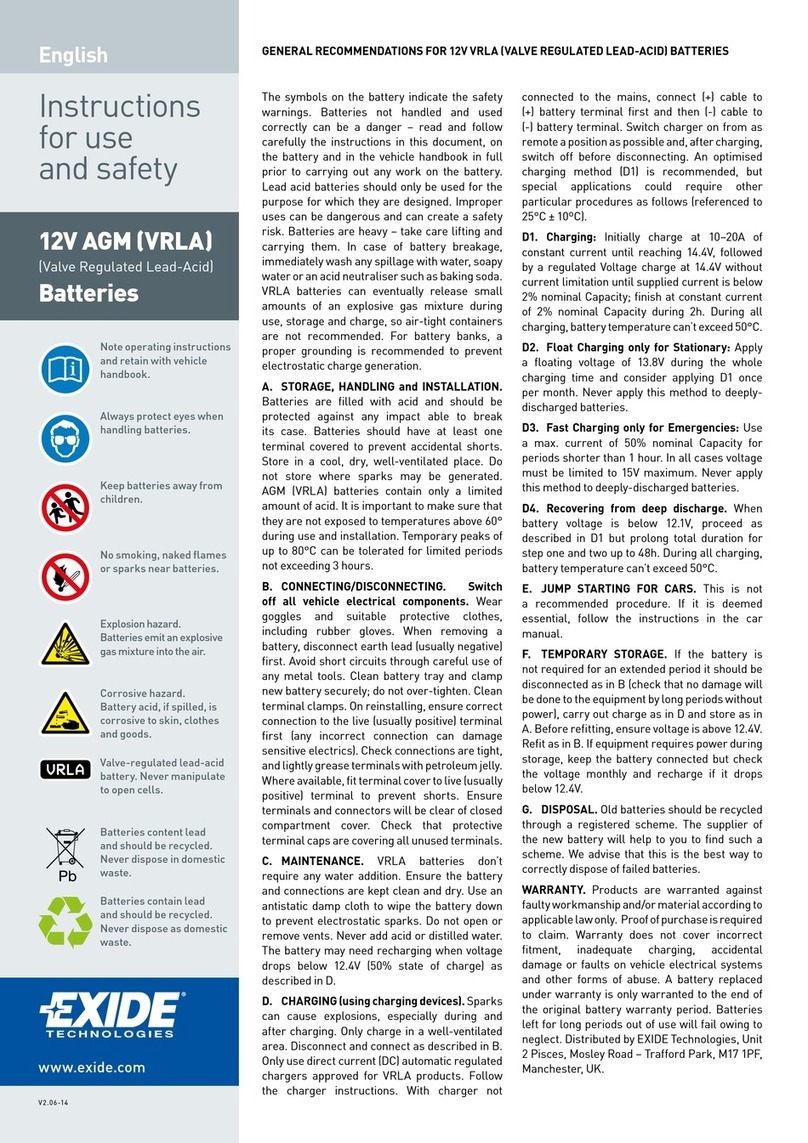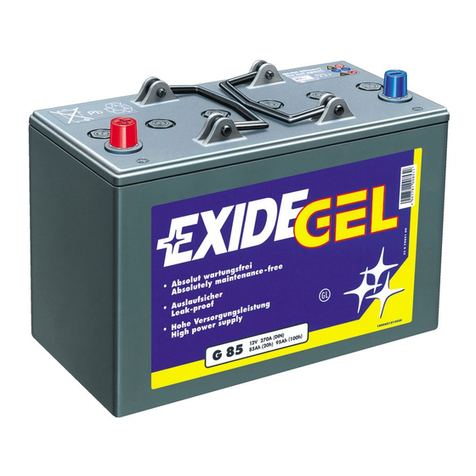Exide EV640 User manual

User guide for
Exide Marine &
Leisure Equipment
Lithium-ion
batteries
EXIDE TECHNOLOGIES SAS
5 ALLÉE DES PIERRES MAYETTES
92636 GENNEVILLIERS
FRANCE
TEL: +33 1 41 21 23 00
FAX +33 1 41 21 27 15
EN
Exide M&L Battery Monitor

5
2
5
index
●English
Warning and general conditions
1. Safety
2. Model range and specications
3. BMS – Battery Management System
4. Battery installation / connection
5. Wireless communication
6. Instructions for safe handling
7. Trouble shooting
pag. 1
pag. 3
pag. 4
pag. 5
pag. 7
pag. 8
pag. 8
pag. 8
pag. 9

5
3
Warning and general conditions
These instructions contain basic information and guidance to be noted and followed during operation and maintenance and
must be read by all users.
● Observe these Instructions and keep them located near the battery for future reference.
● Work on the battery should only be carried out by qualied personnel
● Do not dispose of the batteries in a re
● Do not smoke
● While working on batteries, wear protective eye-glasses and clothing
● Explosion and re hazard. Avoid short circuits
● Avoid electrostatic charges and discharges/sparks
● Caution – parts of the battery may dissipate high currents. Be careful when connecting and handling cables
● Lithium-ion batteries are heavy. Make sure they are installed securely
● Handle with care, the batteries are sensitive to mechanical shock
● Do not lift or pull up on the poles
● Do not wear any metallic items such as watches, bracelets, et cetera
● Never try to open the battery. The electrolyte is very corrosive. During normal operation, contact with the electrolyte cannot happen
● If the battery housing is damaged, any direct contact with the exposed electrolyte or powder might result in injury, as the material is corrosive
● To be prepared for an emergency case the Instruction for Safe Handling of Lithium Batteries shall be read and understood
● Use certied insulated safety tools for installation. Any work procedures and tools used should be in compliance to EN 60900 or similar standard
● Charging the Li-ion battery after it has been discharged below the cut-o voltage or if the Li-ion battery is damaged
or taking it over the nominal charge then the Li-ion battery can release a harmful mixture of gasses
● Keep children away from batteries
● Battery may require recycling in accordance with local legislation
● Contact dealer or regulatory authorities for further information
● Spent Li-ion batteries MUST be returned to Li-ion battery collection points
● DO NOT dispose of the battery in normal waste
● DO NOT return Li-ion batteries together with Lead Acid batteries
● Keep the battery dry
● Pressure washing not allowed

5
4
1. Safety
1.1 General recommendation
Each person given the task of operating or maintaining the battery must have read and understood the instructions. Only qualied
personnel should install the batteries. Knowledge of the contents of the installation and user manual is a fundamental requirement
to protect people from danger, to avoid errors and to operate the system safely and fault-free.
1.2 Installation / Operation
● For the rst use, before connecting the battery packs to your equipment fully charge the battery (see section 2), this will put
battery in good SOC and will calibrate SOC calculation from BMS
● The operating conditions given in the product documentation must be observed
● The battery contains a BMS with integrated protection and with the capability to disconnect all battery power resulting in 0 V and 0 A
● A battery which gets disconnected by BMS during use can lead to immediate loss of function for connected equipment.
Do not install or use in systems where sudden loss of battery power may lead to dangerous situations or result in malfunction or
damage of connected equipment
● The battery is intended for equipment use only. Do not use for starting power (engine crank) or other similar applications
● If the battery is damaged, deformed, abnormally hot or emits an odor, please cut o the power immediately and stop using it and
contact your local dealer
1.3 Battery Maintenance
● Exide Li-ion charger is recommended to be used. If using any other charger it must respect the charging requirements of the
battery (see section 2)
● Depending on battery type, if the battery voltage is lower than 10 V / 20 V / 30 V the BMS will disconnect (over discharge protection)
and enter sleep mode to protect the battery from further discharge. Apply charging voltage to wake up BMS and recharge battery
immediately
● The user should verify the condition of all external cables and connections prior to each operation
● Before carrying out any inspection of cables the battery must be disconnected from the application and the charger
1.4 Storage conditions
● Disconnect all loads from the battery before storage
● In case of long term storage (>6 months), battery must be kept dry and frost free. Storage temperature 15 – 35 °C, recommended
storage humidity 5 ~ 75%
● In case of long term storage (>6 months), maintain battery state of charge (SOC) close to 50% by maintenance charge every
6 months. For seasonal storage (up to 6 months) charge the battery to above 50% SOC before disconnecting
● Suggested storage temperatures up to 1 month -20°C ~ 50℃, up to 3 months -10°C ~ 45°C
● If battery need to be stored for prolonged time (e.g. for winter), recharge them upfront and check battery open circuit voltage,
OCV (voltage at total rest, ideally with nothing connected to battery terminals) regularly every 3 months
● In case OCV >12.6 V battery state of charge is above 10% and can be considered OK. Below 12.6 V battery should be
charged. At 10.5V the low voltage protection is triggered
● To recharge, use Exide approved Li-ion charger or other Li-ion battery charger (lithium iron phosphate, LFP) fullling charger
specications as described in this manual. To recharge a battery in low voltage protection mode, the charger must be able to start
charging from 0 V. Make sure the charger is capable of activating also when battery voltage is 0 V (e.g. use power supply function,
automatic starting function, or similar setting). Note that some chargers do not have this capability and will not be able to «wake up»
a Li-ion battery from low voltage protection, refer to charger manual for details and use a dierent charger if required
5

2. Model range and specications
Model Nominal
Voltage Rated
Capacity Rated
Energy (Wh) BT Heater Serial Parallel Box*
size Dimension
L*W*H (mm) Weight
(Kg)
EV640 12.8 V 50 Ah 640 YYes 2 4 D31 308 x 168 x 211 8.5
EV1250 12.8 V 96 Ah 1250 YYes 2 4 L05 355 x 176 x 190 10.7
EV1300 12.8 V 100 Ah 1300 YYes 2 4 D31 308 x 168 x 211 11.7
EV1600 12.8 V 125 Ah 1600 N No 2 4 27F 318 x 165 x 215 15.0
EV2500 12.8 V 200 Ah 2500 YYes 2 4 F51 485 x 170 x 240 25.0
EV1300/24 25.6 V 50 Ah 1300 YYes No 4 G77 307 x 170 x 216 12.3
EV3800/36 38.4 V 100 Ah 3800 YNo No 4H52 520 x 269 x 221 39.0
5
2.1 Model range and specications
2.2 Heater specication
The batteries equipped with a heater can be charged from -20°C to 45°C. When connecting at -20°C and above the power will be
used by the heater to warm the battery (about 1°C ~3mns) until -2°C. Then the charger will start to charge the battery. Heater will
turn o when the module reaches +5°C.
2.3 Discharge recommendations
Do not exceed below current levels for discharging the battery. If fully discharged (0 % SOC or low voltage disconnect by BMS)
recharge without delay. Never leave the battery in a fully discharged state.
Model Nominal
Voltage Rated
Capacity Temperature range Constant
Discharge Current Peak Discharge (current / duration)
EV640 12.8 V 50 Ah -20°C / 60°C 50 A 170 A +/- 10 A 2s +/- 1
EV1250 12.8 V 96 Ah -20°C / 60°C 100 A 400 A +/- 20 A 5s +/- 1
EV1300 12.8 V 100 Ah -20°C / 60°C 100 A 300 A +/- 20 A 3.5s +/- 1
EV1600 12.8 V 125 Ah -20°C / 60°C 100 A 350 A +/- 20 A 3s +/- 1
EV2500 12.8 V 200 Ah -20°C / 60°C 160 A 400 A +/- 20 A 3.5s +/- 1
EV1300/24 25.6 V 50 Ah -20°C / 60°C 50 A 80 A +/- 5 A 2s +/- 1
EV3800/36 38.4 V 100 Ah -20°C / 60°C 50 A 350 A +/- 30 A 2s +/- 1
Currents higher than maximum allowed MUST BE AVOIDED since may shorten battery life or lead to premature failure, and may damage the
connected equipment if BMS protection occurs
2.4 Charge recommendations
For maximum long term performance and endurance of the battery the standard charge method should be used. Never charge the
battery with voltages or currents above the MAX levels as listed in the tables below.
5
2.4.1 Standard charge
Model Nominal
Voltage Rated
Capacity Temperature
range Charge current
(0.3 C) Charge voltage Cut-o current
(0.05 C)*
EV640 12.8 V 50 Ah -20°C / 45°C 15 A 14.6 V 2.5 A
EV1250 12.8 V 96 Ah -20°C / 45°C 30 A 14.6 V 5 A
EV1300 12.8 V 100 Ah -20°C / 45°C 30 A 14.6 V 5 A
EV1600 12.8 V 125 Ah 0°C / 45°C 40 A 14.6 V 6 A
EV2500 12.8 V 200 Ah -20°C / 45°C 60 A 14.6 V 10 A
EV1300/24 25.6 V 50 Ah -20°C / 45°C 15 A 29.2 V 2.5 A
EV3800/36 38.4 V 100 Ah 0°C / 45°C 30 A 43.8 V 5 A
The standard charge method is CC-CV using the current and voltage levels as listed below.
*The charging should be ended or continue with oat charge voltage when cut-o is reached. It is not recommended to maintain the voltage above
oat charge level when the battery is fully charged
* Indicative, please check dimensions before installation.

5
2.4.2 Charging voltage ranges
6
Model Nominal
Voltage Rated
Capacity Temperature
range MAX charge
voltage* Charge voltage
range** Float charge voltage
(±0.2 V)
EV640 12.8 V 50 Ah -20°C / 45°C 14.6 V 13.6 – 14.6 V 13.8 V
EV1250 12.8 V 96 Ah -20°C / 45°C 14.6 V 13.6 – 14.6 V 13.8 V
EV1300 12.8 V 100 Ah -20°C / 45°C 14.6 V 13.6 – 14.6 V 13.8 V
EV1600 12.8 V 125 Ah 0°C / 45°C 14.6 V 13.6 – 14.6 V 13.8 V
EV2500 12.8 V 200 Ah -20°C / 45°C 14.6 V 13.6 – 14.6 V 13.8 V
EV1300/24 25.6 V 50 Ah -20°C / 45°C 29.2 V 27.4 – 29.2 V 27.6 V
EV3800/36 38.4 V 100 Ah 0°C / 45°C 43.8 V 41.2 – 43.8 V 41.4 V
*Voltages higher than maximum allowed MUST BE AVOIDED since they may shorten battery life or lead to premature failure, and may damage the
connected equipment if BMS protection is triggered
**The higher end of the range is recommended to ensure full utilization of the battery capacity
2.4.3 Charging current ranges
Model Nominal
Voltage Rated
Capacity Temperature
range Standard charge
current* (0.3 C) Fast charge
current** (0.5C) Max charge cur-
rent***
EV640 12.8 V 50 Ah -20°C / 45°C 15 A 25 A 50 A
EV1250 12.8 V 96 Ah -20°C / 45°C 30 A 48 A 80 A
EV1300 12.8 V 100 Ah -20°C / 45°C 30 A 50 A 100 A
EV1600 12.8 V 125 Ah 0°C / 45°C 40 A 80 A 125 A
EV2500 12.8 V 200 Ah -20°C / 45°C 60 A 100 A 160 A
EV1300/24 25.6 V 50 Ah -20°C / 45°C 15 A 25 A 50 A
EV3800/36 38.4 V 100 Ah 0°C / 45°C 30 A 50 A 50 A
C-rate, current (A) as a factor of rated capacity (Ah).
* Recommended current (A) to ensure maximum lifespan
** Recommended current (A) for occasional fast recharge
*** Maximum allowed current (A) (not recommended)
Currents higher than maximum allowed MUST BE AVOIDED. since it may shorten battery life or lead to premature failure, and may damage the
connected equipment if BMS protection is triggered.
5
Do not exceed below current limits for recharging the battery.

3. BMS – Battery Management System
5
7
The battery is equipped with an advanced integrated electronic Battery Management System, BMS. The BMS monitors the state
of the battery by measuring voltages, temperatures and the electrical current in and out of the battery. The BMS performs balancing
of the battery cells inside the battery and operates the heater (for applicable products). Battery models with Bluetooth allow the
user to receive information of the battery status from the BMS.
BMS has a self-learning and SOC calibration function. Calibration needs to charge the battery to 100% SOC
SOC on the mobile Application “Exide M&L” is calculated by the BMS. The BMS has self-power consumption, when battery is left
in storage, due to energy consumption from electronics, this calculation may become inaccurate. Make a full charge to the battery
to get accurate data.
3.1 BMS integrated protection
To protect or minimize damage to the battery from abuse situations there are built-in protection limits for voltage, temperature and
current. Systematic or intentional triggering of the BMS protection must be avoided and may cause permanent damage to the
battery.
When BMS low voltage protection is triggered, battery must be “waken up” by the use of a proper charger (w/o voltage sensing),
and charged to 100% to calibrate BMS and get accurate SoC calculation.
WARNING! If the battery is used outside the permitted ranges the BMS will enter protection mode and trigger an electronic dis-
connect of the battery. Disconnection by the BMS results in sudden loss of battery power and may lead to total loss of function
for connected equipment.
3.1.1 BMS protection levels
For correct operation refer to recommendations and ranges (voltage, current and temperature) for charge and discharge in
section 2.
BMS protection modes
BMS protection modes are listed below including trigger, release and possible or required action to restore battery to normal state.
Triggered protection will be communicated via Bluetooth for batteries with this function.
Protection mode Trigger Release Action to restore
Over charge / Over voltage
Any cell >3.75 V
Battery* >15.0 V (12 V)
Battery* >30.0/45.0 V (24/36 V)
Cell(s) <3.60 V
Battery* <14.4 V (12 V)
Battery* <28.8/43.2 V (24/36 V)
Allow to rest or apply
discharge to battery
Over discharge /
Under voltage**
Any cell < 2.50 V
Battery* <10.0 (12 V)
Battery* <20.0/30.0 V (24/36 V)
Cell(s) >2.80 V
Battery* >11.2 V (12 V)
Battery* >22.4/33.6 V (24/36 V) Apply charge to battery.
Over current charging
Exceeding charging current
ranges, see levels for specic
battery model in section 2.4
Automatic release,
time-out up to 1 minute.
Allow to rest or apply
discharge to battery
Over current discharging
Exceeding discharging current
ranges, see levels for specic
battery model in section 2.3
Automatic release,
time-out up to 1 minute.
Allow to rest or apply charge
to battery
Over temperature
Temperature above allowed
range, see levels for specic
battery model in section 2.3
and 2.4
Temperature within range
(~5 °C margin) Allow battery to cool down
Under temperature***
Temperature below allowed
range, see levels for specic
battery model in section 2.3
and 2.4
Temperature within range
(~5 °C margin) Allow battery to heat up. Apply
charge to activate heater
*Battery voltages are indicative only. Protection is triggered and released by cell voltages
**Note that Bluetooth connection will be disabled while over discharge protection trigger is active
***Batteries with heater will prohibit charge if temperature is too low (<0°C) and utilize charging current to heat up the battery. Charging of the
battery will commence automatically once battery is suciently heated

5
8
5
4.1 Battery orientation
Install the battery in an upright position only. Never upside down or on the sides. Incorrect orientation may lead to premature failure or pose a
safety risk.
4. Battery installation / connection
X
X
4.2 Battery Installation
● Do not install the battery in a place where it is exposed to direct sunlight or sources of heat (e.g. engine compartments, engine
exhaust systems, electrical/hydraulic pumps or any other device which generates heat under normal or exceptional operating
conditions)
● Keep any ammable material away from the battery and its connected loads or chargers
● Do not install in compartments with zero clearance, always leave space around the battery for ventilation and cooling
● Li-ion batteries must always be kept in a well ventilated, dry, clean and dust-free environment
● Never expose the battery to re or extreme heat
● Keep the battery dry and clean from dirt
● Battery surface should be cleaned with a soft, dry cloth made of non-electro conductive material
● Under no circumstances should liquids, cleaning agents or solvents be used to clean a battery
4.3 Precautions for battery serial connection
● Check table 2.1 if serial connection is possible for a specic battery model
● Maximum number of batteries that can be connected in series is listed in table 2.1
● The batteries connected in series must be of the same model, voltage and preferably from the same batch
● Before connecting batteries in series all batteries must be fully charged
4.4 Precautions for battery parallel connection
● Check table 2.1 if parallel connection is possible for a specic battery model
● Maximum number of batteries in parallel is listed in table 2.1
● The batteries connected in parallel should be of the same model, voltage and preferably from the same batch
● Ensure that all parallel wires are identical (length, section and insulation)
● Before connecting batteries in parallel all batteries must be fully charged
The batteries equipped with Bluetooth can be monitored with a mobile phone using the Exide Application. Features that can be
monitored in the app include: battery voltage, current, state of charge, temperature, cycle count and alarms.The Exide Mobile
Application can be downloaded from App Store (iOS) and Google Play (Android).
5. Wireless communication
6. Instructions for safe handling
6.1 Leaking Batteries
● If a battery leaks electrolyte, avoid contact with the leaking liquid or gas. If exposed to the leaking substance, immediately
perform the actions described below:
● Inhalation: Evacuate the contaminated area, and seek medical attention
● Contact with eyes: Rinse eyes with owing water for 15 minutes, and seek medical attention
● Contact with skin: Wash the aected area thoroughly with soap and water, and seek medical attention
● Ingestion: Induce vomiting, and seek medical attention

5
9
6.2 Fire
● Use CO2, Dry Powder or Foam extinguisher if available
● Use copious amounts of water or sand to cover the battery if available
● If possible and safe to do so, move the battery pack to a safe area
6.3 Damaged Batteries
Damaged batteries may be dangerous and must be handled carefully. If a battery is damaged do not use it and contact your local
dealer.
6.4 Transportation
During transportation, the battery should be handled with care and should not be subjected to severe impact. During transporta-
tion, severe bumps and shaking should be avoided, and moisture, rain and long-term exposure to the sun should be avoided.
7. Trouble shooting
7.1 General statements
● Before installation read quick user guide, check operating specications, BMS protection modes and release conditions
● The integrated BMS protection in the battery can disable the battery function if the battery is used outside allowed operating
conditions. Refer to the BMS section in the User Guide for further information
● If there is any issue with the battery function, check if there is any alarm reported in the APP. Note that triggered over
discharge protection also deactivates Bluetooth and connection to the APP will not be available
● For battery failure analysis, disconnect the battery from the application, e.g. equipment, charger, etc.
● When checking the battery voltage the battery must be disconnected from any equipment for accurate measurement.
Use a voltmeter or multimeter (DC voltage, recommended range 0-20V or 0-100V depending on battery voltage rating 12, 24 or
36V ):
• If the voltage is below 10.5 V (±0.5 V) you will not be able to read APP, refer to point 1 below
• If voltage is above 10.5 V (±0.5 V) refer to points 2, 3, 4 and 5 below
● To support correct analysis record and provide screenshots and / or register alarms data/values from the APP
7.2 Voltage issue
● The battery voltage on the terminals is 0 V
• The battery may have internal open circuit by triggered BMS protection. Check if there are any alarms in the APP. Note that
triggered over discharge protection also deactivates Bluetooth and connection to the APP will not be available
• Charge the battery if there are no alarms in the APP or if the APP is unavailable. Note that some chargers will not activate if the
battery voltage is too low - make sure the charger can supply power even if the battery is at 0 V. Recommended to use Exide
Li-ion charger
• In case of no voltage output on the terminals also after above steps including attempting to charge the battery it needs further
investigation contact Exide dealer
● The battery voltage on the terminals is >0 V to 10 V
• The battery may have internal open circuit by triggered BMS protection. See above points for 0 V output
• Battery voltage around 10 V: While this is a very low voltage it is normal but at the limit of low voltage protection by the BMS,
at this voltage the battery is fully discharged. Batteries should never sit at a fully discharge state – recharge the battery without
delay
7.3 Notications in “systems info” menu in the APP
● If there is any issue with the battery, check the “systems info” menu in the app to see if there is any notication. Refresh the tab
to make sure it is updated
● If BMS protection is triggered a notication is displayed in the “systems info” menu in the APP. The notication will stay until the
condition triggering the BMS protection is restored to normal
● Notications will remain until the battery is used. Recharge the battery and restart the APP if the notication is still present
even after the condition triggering the BMS protection is restored to normal
● In case there notication remains after following above points or if there is no notication in the APP on your issue contact
Exide dealer
7.4 On “advanced information”
● To access to alarms page, enter code : 1234
● Check alarms and then refer to user guide for alarms release conditions
● In case of low voltage over discharge protection is triggered there is no communication to the mobile APP. The battery
must be recharged to activate the Bluetooth function again
● For High temperature, both discharge (HTD) and charge (HTC) will trig o, this is normal
● To change the name of a battery in the app use, enter code: 5678. Note that it may take some time after name change until
the name is updated in the App, try to disconnect and reconnect to the battery if the name is not updated in the App after a
name change

5
10
7.5 Bluetooth issue
● ( Pre-conditions: Battery voltage as measured on the battery terminals should be > 10.6V) Recharge the battery to restore
any low voltage protection that might deactivate the Bluetooth function
● The APP does not connect to the battery
• Make sure Bluetooth is enabled on the mobile phone and that the battery is not too far away
• If problem remains try to delete and re-install the APP
• Remove or turn o any other Bluetooth equipment or other sources of potential interference 2.4 GHz such as Wi-Fi that may
interfere with the signal
• If possible try to connect to another battery or use another mobile phone to install the APP
• In case the problem persists contact Exide dealer
7.6 Heating system
● Pre-condition: Battery temperature below 0 °C and above -20 °C to be below for the heater to start working and the charger
to start charging the battery)
• At temperatures above 0 °C (±3 °C) the battery will accept charge and the heater will not activate
• At temperatures below -20 °C (±3 °C) the battery will be fully disabled and the heater will not activate
• Check that there are no other alarms of BMS protection triggered in the APP
● If the battery does not accept charge when temperature is in the range -20 °C to 0 °C
• Check the battery temperature in the APP to conrm that it is within the range where the heater is active
• Check that the charger is active and can supply charging voltage and current
• In case of not visible charge or temperature increase from the APP contact Exide dealer
Other manuals for EV640
1
This manual suits for next models
6
Table of contents
Other Exide Camera Accessories manuals
Popular Camera Accessories manuals by other brands

Trojan
Trojan GC2 48V quick start guide

Calumet
Calumet 7100 Series CK7114 operating instructions

Ropox
Ropox 4Single Series User manual and installation instructions

Cambo
Cambo Wide DS Digital Series Main operating instructions

Samsung
Samsung SHG-120 Specification sheet

Ryobi
Ryobi BPL-1820 Owner's operating manual
